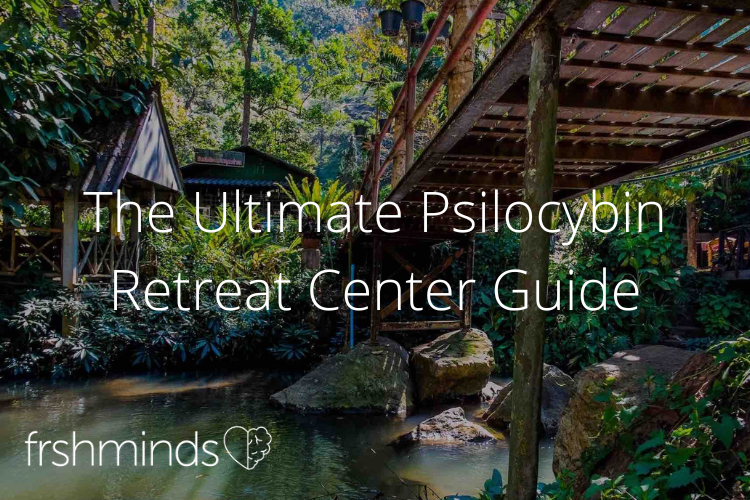
The Ultimate Psilocybin Retreat Center Guide
Welcome to Frshminds’ Psilocybin Retreat Center Guide.
Be forewarned picking the psilocybin retreat that works for you is not an easy task, as a lot of prerequisite knowledge comes into play. Just like climbing a mountain involves more than buying some mountain climbing gear, booking a retreat involves more than just finding a retreat and booking a ticket. Making an educated retreat decision involves asking retreat operators the right questions, which means you need knowledge and understanding of the following:
- The benefits of a psilocybin retreat.
- Why psilocybin may be right for you.
- Psilocybin mushrooms potency and consumption methods.
- What is reasonable to expect when you attend a psilocybin retreat?
This is where the Frshminds’ Psilocybin Retreat Center Guide comes in, helping transform you into an educated consumer.
Our psilocybin retreat center guide is divided into six parts, gradually progressing from a basic understanding of why you might want to consider using psilocybin on through to the basic science, the fundamentals of psilocybin, how psilocybin mushrooms are consumed and then on to the specifics of selecting a psilocybin retreat.
Alternatively, if you are already knowledgeable about psilocybin and just want to select a retreat, make use of Frshminds’ psilocybin retreat directory.
How to Use The Psilocybin Retreat Center Guide
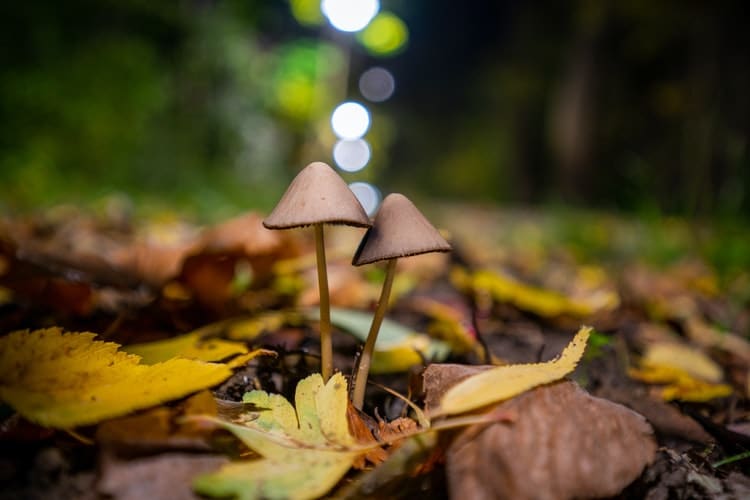
You can read the Psilocybin Retreat Center Guide in its entirety or use the links below to navigate to the individual sections.
Part 1: What Is a Psilocybin Retreat? Let’s start off with learning a bit about psilocybin retreats, so we can move on to learn why you may want to attend one.
Part 2: Psilocybin. Is it right for me? Before rushing into the details of psilocybin itself, let’s hear from some psychedelic therapists and users on their experiences with psilocybin and psychedelics, including the perceived benefits and how they approach therapy.
Part 3: The Basic Science of Psilocybin. Now, let’s nerd out and dive into the science of psilocybin. When you finish this section, you’ll understand the following:
- The basic chemistry of psilocybin
- Why psilocybin might help certain conditions
- What happens to your body when you consume psilocybin?
Part 4: What You Need to Know About Psilocybin Mushrooms. Next up is your chance to learn everything you need to know about psilocybin mushrooms. We answer questions like:
- Where are psilocybin mushrooms found?
- How do you judge the potency of psilocybin mushrooms?
- Are there different species of psilocybin mushrooms?
Part 5: How Do You Consume Psilocybin? Before you select a psilocybin retreat, its important to understand both how much psilocybin you might consume as well as the different ways of consuming psilocybin you may need to choose from, including:
- The difference between psychedelic truffles and mushrooms.
- Microdosing.
- Mushroom tea.
Part 6: Selecting a Psilocybin Retreat. As we have now gotten you up to speed on the basics of psilocybin mushrooms, you are now ready to learn about selecting a psilocybin retreat that meets your need by providing you with:
- Advice for attending a retreat, including an understanding of where they are located in the world.
- An understanding of what goes on at a retreat.
- Interviews with retreat operators so you can understand the different retreat approaches.
- Access to Frshminds’ ever-growing directory of psilocybin retreat centers.
More Frshminds Psychedelic Guides
Be sure to check out all of our guides
- The Ultimate Psilocybin Retreat Center Guide
- The Ultimate Ayahuasca Retreat Guide
- Frshminds’ Guide To Ketamine Clinics
Part 1: What is a Psilocybin Retreat?
Before investing the time in learning how to select a psilocybin retreat, let’s first make sure you understand what a psilocybin retreat is and why you might want to go.
Are There Different Types of Psychedelic Retreats?
First off, it’s important to know that in addition to psilocybin retreats, you will come across different types of psychedelic retreats in your research process, each offering different plant medicine, set and setting, staff credentials, integration and a lot more. Many things differ from one retreat to another, including cost, size, length of stay, legal status, etc. Do your homework here to find out what works best for you.
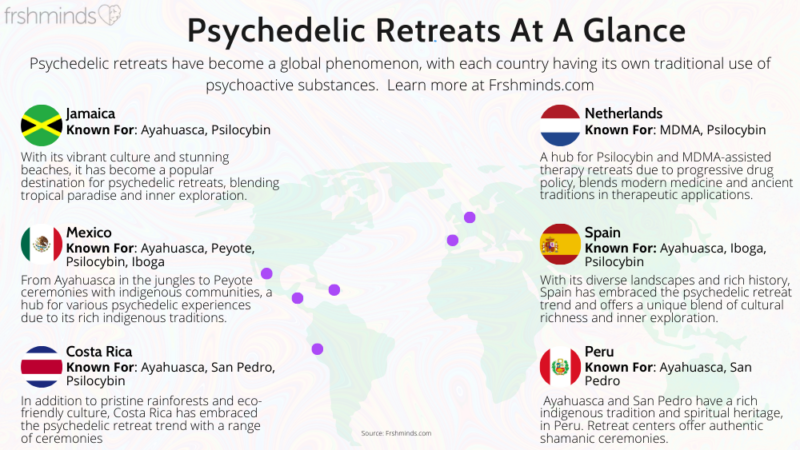
In most situations, a psilocybin retreat is usually an overnight program at a facility where trained therapists administer psilocybin to the guests to help them reach their mental health objectives. Most advocates seek destinations where psychedelic mushrooms can be consumed in a safe, controlled and moderated environment.
Why Select a Psilocybin Retreat
For many reasons, someone may partake in a psilocybin or magic mushroom retreat over retreats that offer other psychedelics, such as ayahuasca, San Pedro cactus, or ibogaine. Although experiences with psilocybin mushrooms can be very intense depending on dosage, they are generally considered more gentle than, for example, ayahuasca which involves purging (vomiting), extraordinary visual experiences and even out-of-body experiences.
Psilocybin retreats are usually less time-consuming as well. Where an ayahuasca retreat may last up to 14 days, psilocybin retreats range from a few days to a week at most. Aside from this, psilocybin mushroom retreats may be more appealing from an ethical regard of impacting local economies, the environment, or implications surrounding cultural appropriation.
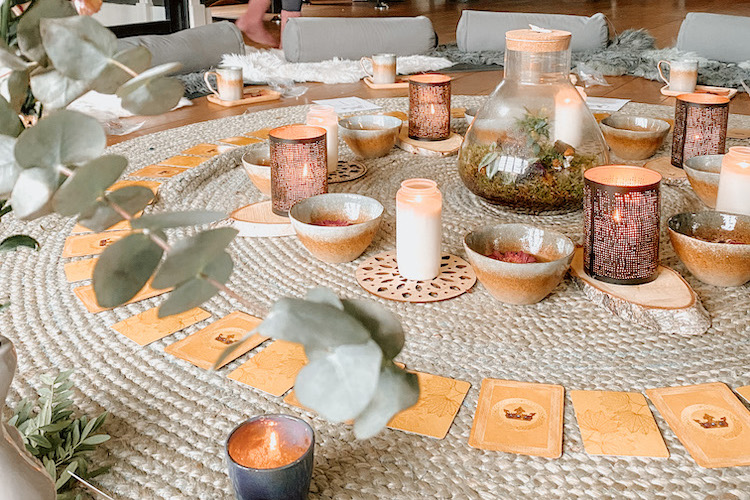
Psychedelic retreats often offer a psychospiritual and ceremonial context. They typically feature elements of the traditional and/or indigenous ceremonies that have been intertwined with psilocybin throughout history. They can last anywhere from a weekend to a week or longer, with the length of time being driven by the number of ceremonies held. A typical psilocybin ceremony lasts 5 to 6 hours, with ceremonies held at various spiritual centers, including yoga or meditation. These centers are proliferating worldwide, throughout Latin America, quietly throughout North America, and in places like Jamaica and the Netherlands, where they are decriminalized.

So what are the benefits of going to a psilocybin retreat?
Psilocybin stimulates your self-consciousness, allowing you to surface, deal with deep traumas, and help you evolve your neural pathways. What intentions a person brings with them can define how successful the psilocybin treatment is. Based on the latest scientific studies, many people seek out psilocybin mushroom retreats to seek relief from depression, anxiety, smoking addiction, drug addictions, end-of-life anxiety, alcoholism, and even post-traumatic stress disorder. People not seeking help for these afflictions may still participate in a retreat to heal from trauma and childhood wounds or to experience soul expansion.

A retreat setting is a wonderful place to receive your psilocybin journey. Being away from your daily life may make you less concerned about your stresses and open you to absorbing the medicine. Having a dedicated team around you, guiding your integration and cooking your meals, make you better able to focus on your work. And you may find that there is strength in numbers as other guests join you in sharing their insights and experiences.
Part 2: Psilocybin. Is It Right For Me?
What is it, and Where Did it Come From?
Psilocybin is a psychedelic medicine derived from certain types of mushrooms. They are used in various healing and therapeutic contexts (ceremonial, spiritual, psychotherapy, etc.) to alleviate traumas and surface the subconscious.
Psychedelic mushrooms have been used by mankind for millennia. Some of the earliest evidence of psychedelic mushroom use dates back to the Olmecs and Maya of Mesoamerica. But in modern times, psychedelic mushrooms didn’t really enter the public consiousness until the 1950s.

At that time, amateur American mycologist R. Gordon Wasson heard a legend of local people using psychedelic mushrooms and travelled to Mexico to see it firsthand. The adventure took him to Huautla de Jimenez in Oaxaca, where he met the famous curandera (healer) Maria Sabina. She conducted a psychedelic mushroom ceremony with Wasson. Afterwards, Wasson wrote a feature article for Time magazine about the experience. Psychedelic mushrooms entered American consciousness with a bang.

Living in a Psychedelic Revival
For decades thereafter, psychedelic mushrooms became highly stigmatized. Bogus research and propaganda quickly led to the criminalization of psilocybin worldwide. Only within the last few decades have shrooms started to rehabilitate their image. Today, thanks to science, we are finding out that psychedelics aren’t “drugs.” Psychedelics are, in fact, medicine.
So, how did “drugs” become medicine?
Many high-quality, peer-reviewed research studies are so compelling that they have touched off a psychedelic revival. A wide range of psychedelics that includes mescaline, MDMA and ayahuasca have proven their therapeutic benefits time and time again.
Mainstream culture is quickly becoming another place to witness this revival. Psychedelics have been featured in books, documentaries, conference panels, songs, videos a hit Netflix series- Nine Perfect Strangers.
What Users and Therapists Say About Psilocybin
Before deciding to undertake a psilocybin retreat, it’s important to hear from both users and therapists who have worked with psilocybin to get an idea of what you can expect to experience on your journey.
Are You A Hard-driving Professional Feeling The Effect of Burnout and Fatigue?
You might be interested in hearing from Peggy Van de Plassche. Peggy, a former banker turned psilocybin microdosing advocate, documented her psilocybin retreat experience at Journeyman Collective in British Columbia, Canada. The article explains how the medicine has benefited her personally and professionally.
Considering psychedelics to aid in your recovery from trauma and addiction?
Watch Frshminds’ interview with former NHL player Riley Cote, discussing his beneficial experience with psilocybin to heal from concussions, chronic injuries and substance abuse issues. Cote also touches on how psilocybin changed his personality and optimized his life.
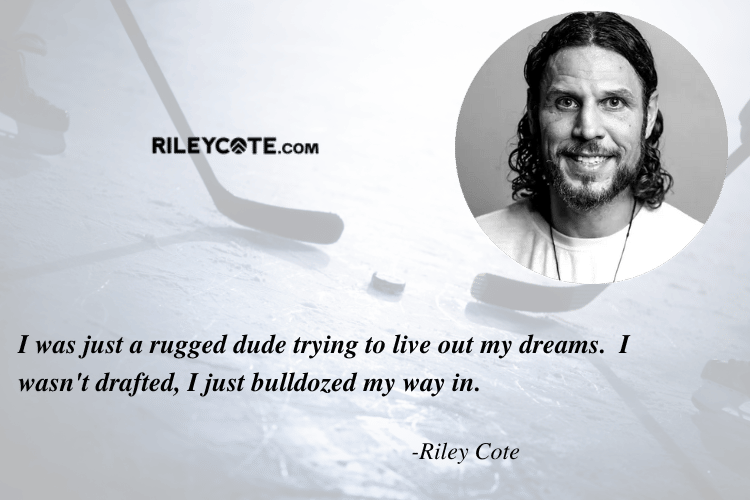
The Therapists’ Perspectives
Before selecting a retreat, it is important to understand the perspective of the therapists or shaman running the retreat to ensure it aligns with your purposes for going to a particular retreat. Jesse Hanson, PhD of Dimensions Retreats, provides a good overview of the influences shaping today’s psychedelics industry while touching on the holistic approach of Dimension Retreats, his experience studying plant medicine for a year and reveals how there is medicine inside all of us.
Psychotherapist Heather Lee of Medicine Woman Retreats shares her lifelong fascination with altered states of consciousness and her experiences with psilocybin that helped her see psychedelic mushrooms as a powerful tool.
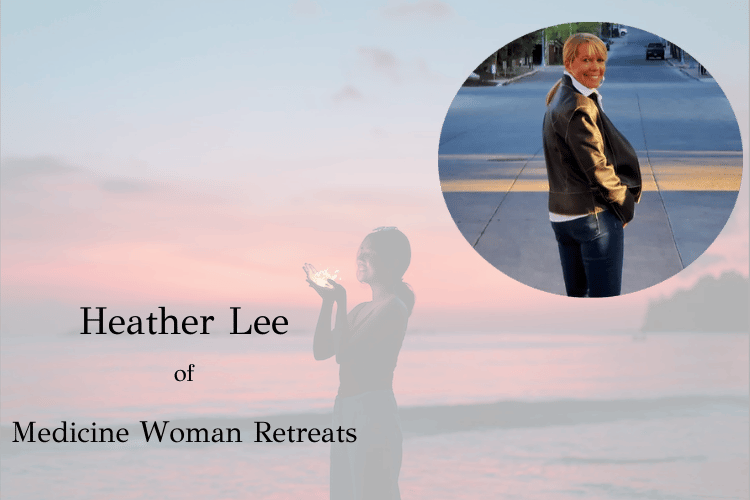
Part 3: The Basic Science of Psilocybin
Now that you know why you might consider it a treatment option let’s nerd out on the basic science of psilocybin. After reading this section, you’ll have a good general overview of the chemical and how it works in your body. While this won’t make you a research scientist, it will make you a well-informed and highly sought-after dinner party guest 😉
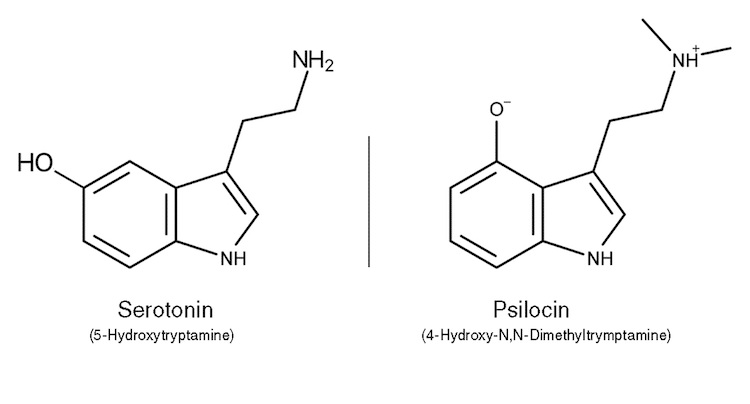
First off, let’s find out exactly what kind of drug psilocybin is and what will it do to you. The short version of the story is that psilocybin is metabolized into psilocin, which, because it is similar in structure to serotonin, a neurotransmitter found in humans, alters brain function in several ways, including:
- Euphoria
- Alterations in perception
- Mental and visual delusions
- A distorted concept of time
- Spiritual experiences
- This can lead to possible unfavourable reactions like anxiety attacks and nausea.
How Does Psilocybin Impact Your Brain?

If you are still curious to learn more about how Psilocybin may “remodel” your brain, be sure to read our article, “What Happens In Your Brain When You Take Psilocybin?” by Lisa Batten, a psychedelic scientist and trained therapist with a master’s degree in clinical psychology and a Ph.D. in developmental psychology, which will explain how researchers think psilocybin changes neural pathways.
Understanding Psilocybin: Effects and Detection
When you first delve into the world of psilocybin, an intriguing aspect you may notice is the discrepancy between how long you experience its effects and the duration it actually stays within your system. After consuming psilocybin, it generally takes about 20 to 40 minutes for the initial effects to manifest, reaching their peak roughly 90 to 120 minutes post-consumption. The most intense effects usually subside within six to 12 hours.
While it’s challenging to provide exact numbers, the following are commonly accepted detection time frames for psilocybin:
- Urine: Up to 24 hours. However, it’s crucial to note that most corporate standard drug tests do not include psilocybin in their screening.
- Blood: Less than 24 hours. This is a rather rare scenario primarily due to the short duration psilocybin remains detectable in the blood, necessitating almost immediate testing post-consumption.
- Hair: Up to 3 months, similar to other substances.
Learn more on the topic by reading “How Long Does Psilocybin Stay in Your System?”
Part 4: What You Need to Know About Psilocybin Mushrooms
Congratulations on making it this far. In Part 4 of our psilocybin retreat center guide, we will impart some serious knowledge about the magical funghi you will be consuming at a retreat.
Magic Mushrooms vs Psilocybin Mushrooms?
First off, you need to know that magic mushrooms and psilocybin mushrooms are the thing, so what exactly is a psilocybin mushroom? Well, duh, it’s a mushroom that contains naturally occurring psilocybin (clearly a blinding flash of the obvious) and if you to learn the basic, including how they may have been integral in the evolution of the human brain, be sure to read What are Magic Mushrooms? A Primer on a Classic Psychedelic.
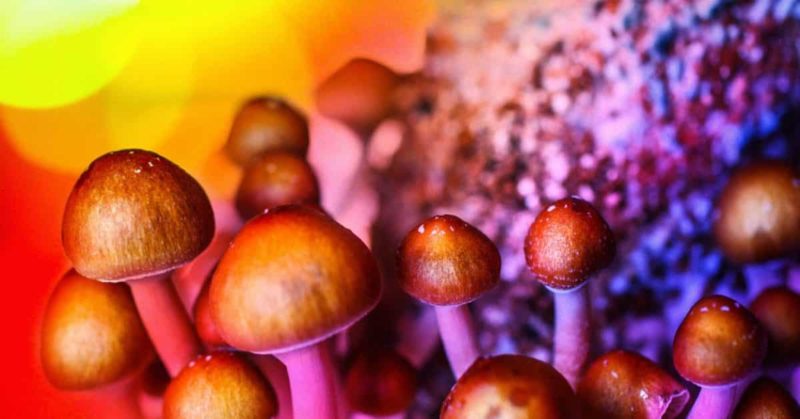
But the truth is that you are anything but basic, so let’s push a little deeper into the world of psilocybin mushrooms.
First off, did you know there are over 200 types of psilocybin mushrooms?
What? Are you serious? How in the world am I supposed to know which mushrooms I am supposed to take?
While this may seem overwhelming, it’s actually not; nevertheless, we should take this opportunity to understand how psilocybin mushrooms are classified. Mycologists, scientists who study mushrooms, use a ‘taxonomy’ to organize and name the different types of magic mushrooms (you can learn more about the different types by reading our Psilocybin Mushroom Species Guide).
While our article, The Taxonomy of Magic Mushrooms, breaks down the entire naming and classification process, the only thing you really need to know is that while many people refer to the different types of magic mushrooms as strains, similar to cannabis, the correct terminology is to refer to the different types of mushrooms as species and subspecies. Dive into the debate with our Magic Mushroom Species vs. Strain article.
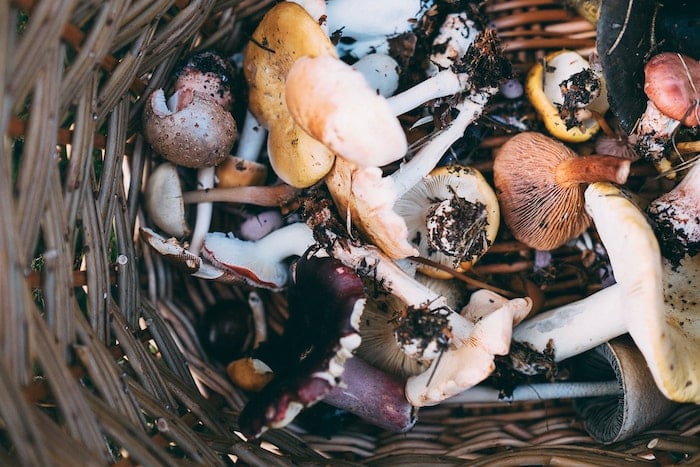
And while there are approximately 180 to 220 or so mushrooms species and subspecies considered to be psychoactive, the following are the ones you are most likely to encounter at any retreat:

Golden Teacher Magic Mushrooms: A psilocybe cubensis subspecies that is one of the most well-known and offers a mix of mental and bodily effects. Fruiting bodies are medium-large, and the conical, orange-brown caps often have distinct white speckling. The stem (stipe) is white and becomes thicker towards the base.
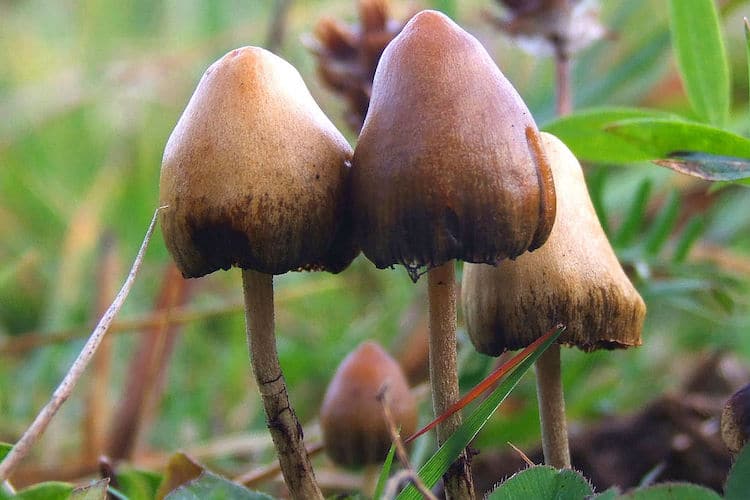
Psilocybe Semilanceata: Also known as “Liberty Caps,” they were implicated in the first well-documented case of psilocybe intoxication when a dad and his four children found them while mushroom foraging in London’s Green Park at the close of the 18th century.
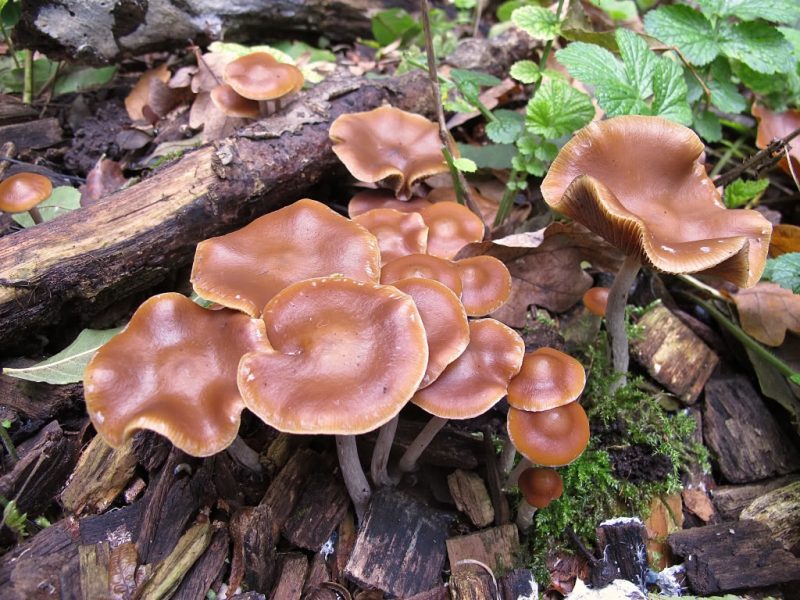
Psilocybe Cyanescens: Better known as Blue Meanies or “Wavy Caps”. While they were first collected by Elise Wakefield, an English mycologist, in the early 20th century and described in 1946 in Transactions of the British Mycological Society, the name was popularized as the titular antagonist of The Beatles film Yellow Submarine (1968). They are named for their blue bruising and are famed for their potency and commonality.
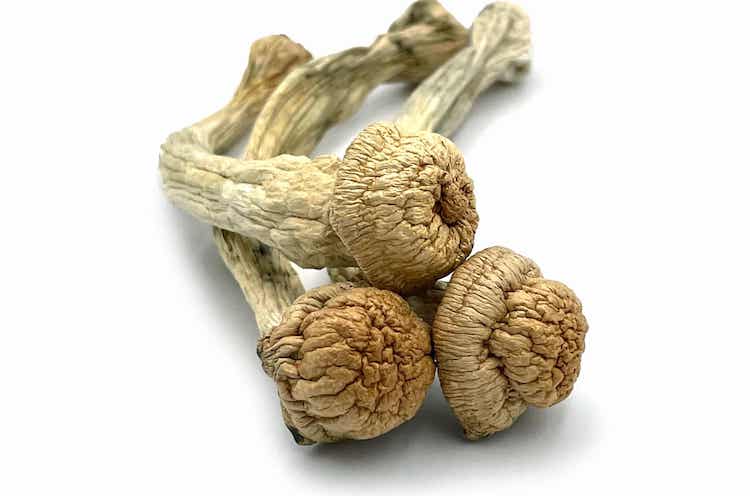
Penis Envy: Frequently considered one of the strongest of the psilocybe cubensis subspecies, it is named for its phallic physical appearance which includes an underdeveloped, bell-shaped cap (pileus) that is caramel brown in colouration and thick stems (stipes). The undeveloped bulbous cap that looks more rounded than the typical psilocybin Cubensis strain due to the lack of a ‘velum or veil’ separating the shroom’s stem from the cap.
If you are looking to further enhance your psilocybin mushroom knowledge before heading off on a retreat, check out the following resources on Frshminds:
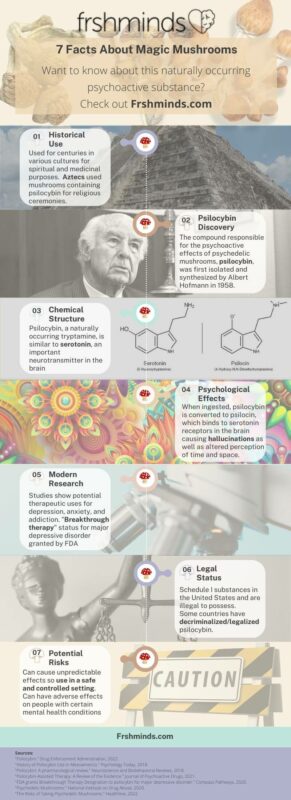
Understanding and Measuring Magic Mushroom Potency
If you are going to pay attention to one part of this guide, this is probably it, as the one question all newcomers to the world of psilocybin mushrooms ask is, “Just how strong are these things????”
Beyond the fact it’s really important to what you are putting in your body, the most important thing to understand about the potency of psilocybin mushrooms is that it is highly variable as it is based on
- The chemical constituents of magic mushrooms
- Brain chemistry and dosage
The takeaway message is that while the different potency measurement techniques result in different results as to which type of mushroom is the most potent, it is important to note that there is a large amount of variability in the concentration of psychoactive within any given mushroom species, so if this is your first time taking psilocybin mushrooms, go slow and keep the dosage low.
While we go into great detail on the topic in our articles Understanding and Measuring Magic Mushroom Potency, and What is the Strongest Magic Mushroom, the general consensus on mushroom species strength is:
| SPECIES | % PSILOCYBIN | % PSILOCIN | % BAEOCYSTIN | |
| P. azurenscens | 1.78 | .38 | .35 | |
| P. bohemica | 1.34 | .11 | .02 | |
| P. semilanceata | .98 | .02 | .36 | |
| P. baeocystis | .85 | .59 | .10 | |
| P. cyanescens | .85 | .36 | .03 | |
| P. tampanensis | .68 | .32 | n/a | |
| P. cubensis | .63 | .60 | .025 | |
| P. weilii | .61 | .27 | .05 | |
| P. hoogshagenii | .60 | .10 | n/a | |
| P. stuntzii | .36 | .12 | .02 | |
| P. cyanofibrillosa | .21 | .04 | n/a | |
| P. liniformans | .16 | n/d | .005 |
Now that we have covered what exactly you are putting into your body at a psilocybin retreat, let’s move on to understanding the process of how it gets in your body.
Part 5: How Do You Consume Psilocybin?
Since your plan is to go to a psilocybin retreat, chances are extremely high that you will be given the opportunity to take psilocybin, but it is important to prepare yourself for the occasion by understanding to salient points about the process:
- How much psilocybin should you take?
- What are the different ways to consume psilocybin?
How Much Psilocybin Should You Take?
The amounts listed here assume that you are taking a mild psilocybe cubensis species, but if you are taking a strain like Penis Envy or Flying Saucers, you should take much less. While you will have guides at the retreat who advise you on dosages, it is important to have a basic understanding of generally accepted dosages, as, ultimately, you are responsible for your own well-being.
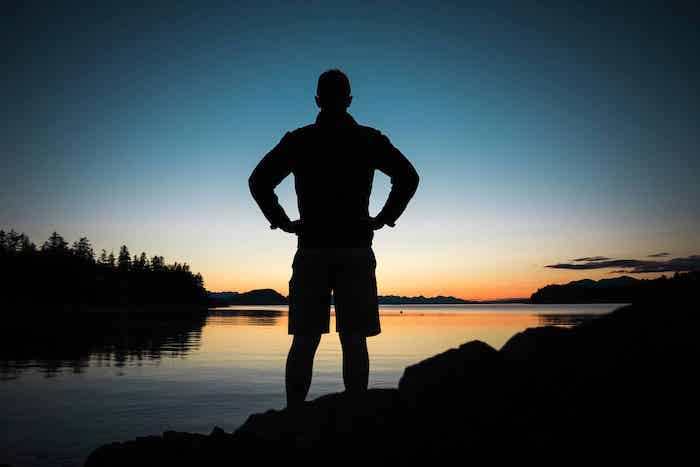
- For a few rare people, doses as small as 0.25 of a gram produce full-blown effects associated with high doses. Although, for most people, this would be considered a “microdose.”
- 0.25–1 gram is a mild effect for most
- 1–2.5 grams usually is a moderate effect, also known as “Museum Dose,” a term popularized by Sasha Shulgin.
- 2.5 grams and higher typically produce strong effects. For most people, 3.5 dried grams (1/8 oz) would be considered a high dose and an intense experience. This is, however, typically considered a standard dose among recreational users.
- For many individuals, doses above three grams can be overwhelming and are known as the “Heroic Dose,” a term popularized by Terence Mckenna.
Ethnobotanist and psychonaut supreme Terence McKenna coined the term “heroic dose.” The psychedelic philosopher recommended eating five dried grams of psilocybin mushrooms to achieve a mystical breakthrough. A strong dose, on average, is 3.5 grams. Please do not try a heroic dose at home; consult your doctor or healer first. Learn more in our article “What is the Heroic Dose?”
What Are The Different Ways To Consume Psilocybin?
Now we are getting down to brass tacks on your journey to evaluating which psilocybin retreat is best for you, and know which methods of consumption do they use. As you might have guessed, retreats use different psilocybin consumption methods, each with pros and cons, that you should know about before you select a retreat to attend:
Whole mushrooms: Some retreats may give you your dosage of psilocybin in the old-school (like 5000 years old-school) form of whole mushrooms. Typically dried out, whole mushrooms can be a bit fibrous, and many people report that they experience some stomach discomfort after eating them.
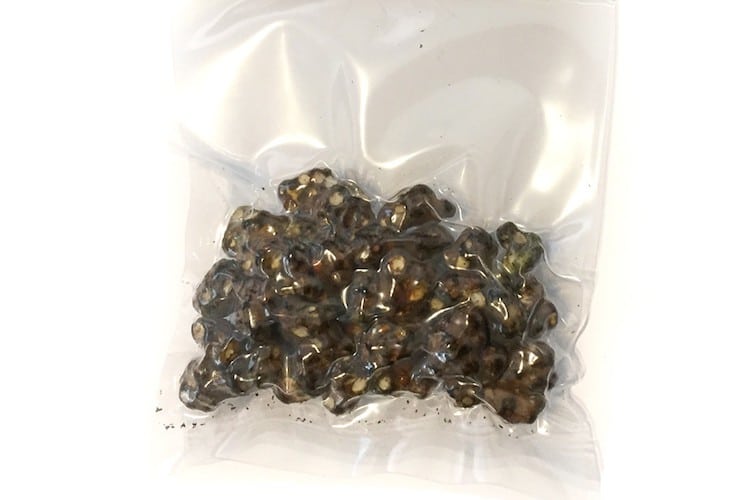
Psychedelic truffles: Some psilocybin retreats, typically in Europe, use psychedelic truffles rather than mushrooms due to some bizarre legal requirements in the Netherlands. The truffles are really just the roots of psilocybin mushrooms and have all the same effects. Learn more by reading our Psychedelic Truffles: What Are They? and Psychedelic Truffles vs. Mushrooms: What’s The Difference articles.
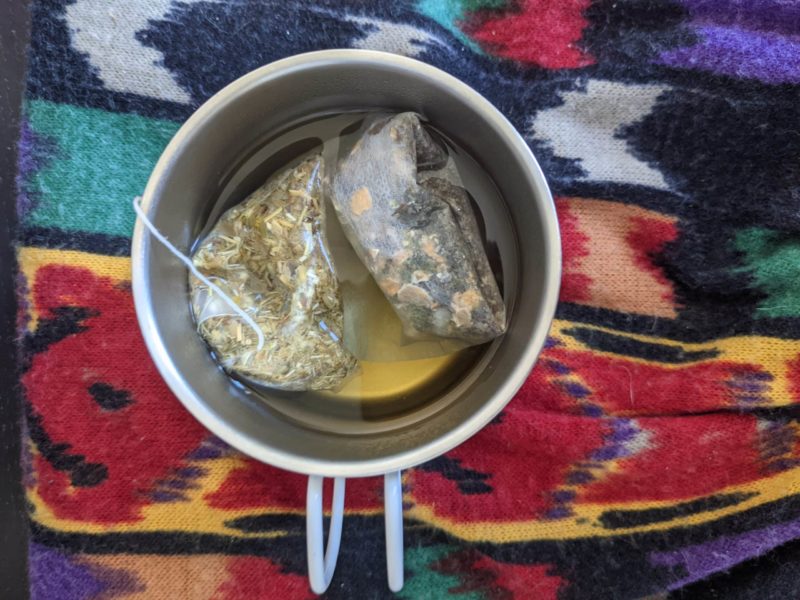
Psilocybin mushroom tea: As discussed in our Magic Mushrooms: Tea vs. Eating article, in order to avoid the gastrointestinal distress of eating raw mushrooms, some retreats may serve you a tea or drink made from psilocybin mushrooms. While there is some disagreement on whether this is a more effective way of consuming psilocybin, it is usually a pleasant experience. There are numerous recipes for how to make magic mushroom tea, and some retreats may serve you something called Lemon Tek, which involves allowing your magic mushrooms to sit in lemon (or lime) juice for up to 20 minutes.
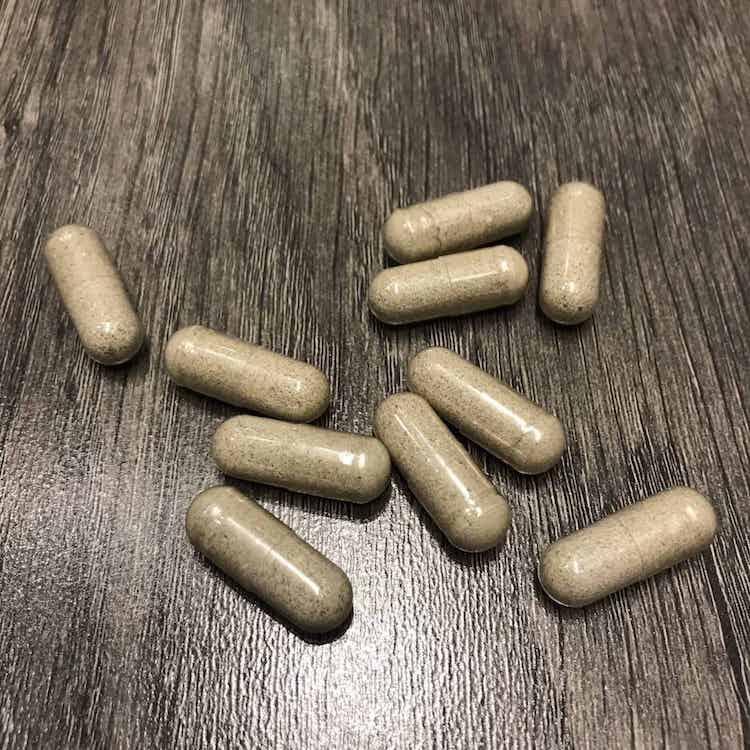
Microdosing: While most people go to a psilocybin retreat for macrodosing, there are some retreats that may offer or discuss microdosing psilocybin. Microdosing is popping just enough of a chosen psychedelic to alter one’s brain chemistry but not enough to trip out. it is important to note that most of the microdose conversation is still anecdotal and limited to fringe communities as psychedelic research is struggling to keep pace with microdosing culture. To learn more about microdosing, check out Frshminds’ guide to microdosing.
Part 6: Selecting a Psilocybin Retreat
Wow, finally…
We’ve gotten through the fundamentals of psilocybin; it is time to get into the weeds of selecting a psilocybin retreat that meets your needs. If you are already knowledgeable about psilocybin and just want to select a retreat, make use of our comprehensive psilocybin retreat directory.

In the famous words of Franklin Delano Roosevelt, “The only thing we have to fear is fear itself.” Fear plays nasty tricks on our minds, and we want to keep them fresh and free from fear. The best tool to eliminate fear is education. Our fear of something often stems from a lack of education about it. Thus, in a space that desperately needs it, we strive to educate people about the safe, controlled and therapeutic use of psychedelics and psilocybin.
So where do people use psilocybin in a safe and controlled setting?
People use psilocybin at wellness centers and retreats. When looking into spiritual first aid, you must respect, like and trust your psychedelic provider, healer, shaman, trip sitter, or whoever. We will help you vet psilocybin wellness and retreat centers worldwide. Frshminds.com lists fantastic psilocybin retreats that span the globe.
What To Look For in A Psilocybin Retreat
Start by setting out some criteria for your decision. Based on interviews with retreat attendees and operators, there are about seven items you should look at
- Location: Retreats offer a range of settings across many countries in Europe, South and Central America and can be found deep in the rainforest, on the beach or in urban centers.
- The Program: Check what the center offers besides the psilocybin experience itself.
- Check out the Facilitators: Choose a retreat led by experienced, qualified and properly trained professionals.
- Safety Protocols: Ask questions about their safety protocols. Make sure they’re clear and include medical supervision and emergency procedures.
- Legal Status of Psilocybin: Remember that psilocybin is illegal in many countries. However, there are countries (e.g., Canada, the Netherlands, Portugal, etc.) where it has been decriminalized or allowed for medical use. Additionally, a lot of countries have a very relaxed stance on the enforcement of drug laws. Choose a psilocybin-friendly destination to ensure you have a relaxing and problem-free experience.
- Read Reviews: Browsing for reviews and testimonials from previous participants is the best way to know what to expect from a retreat.
- Budget: Retreats come in various budgets, from luxury resorts to sleeping in a hammock under the stars. Find one that matches your budget.
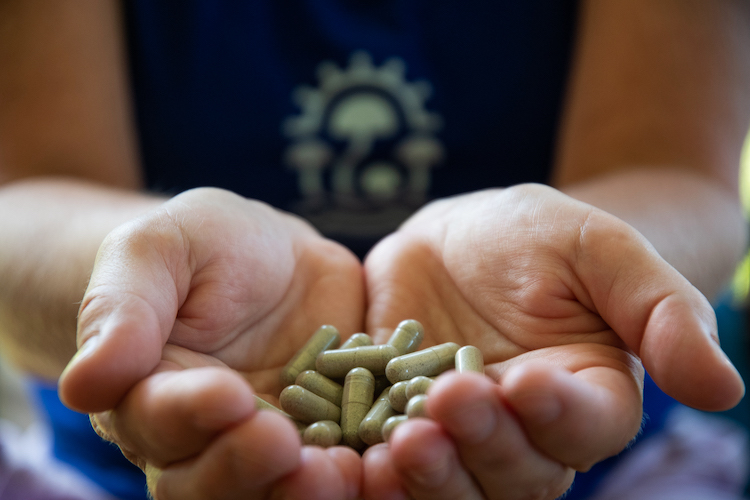
Learn more about setting your retreat selection criteria in our The Best Psilocybin Retreats: What To Look For article.
Psilocybin Retreat Center Guide: A Country By Country Review
Based on research in our Best Countries for Psilocybin Retreats article, upwards of a dozen countries, spread out from Europe to North America, to South America, offer various psilocybin retreats. Each of our review articles contain:
- Retreat reviews,
- Pictures of retreats
- Interviews with retreat operators
Psilocybin Retreat Center Guide: The United States
The state of Oregon is one of the first states to trailblaze a new psychedelic path forward. A few years ago, the state voted in favor of legal psychedelic psychotherapy using psilocybin. However, the transition has not been without challenges. Find out what psilocybin treatments may be available to you in Oregon or not in our Psilocybin Retreats in Oregon: Real or a Mirage? article.
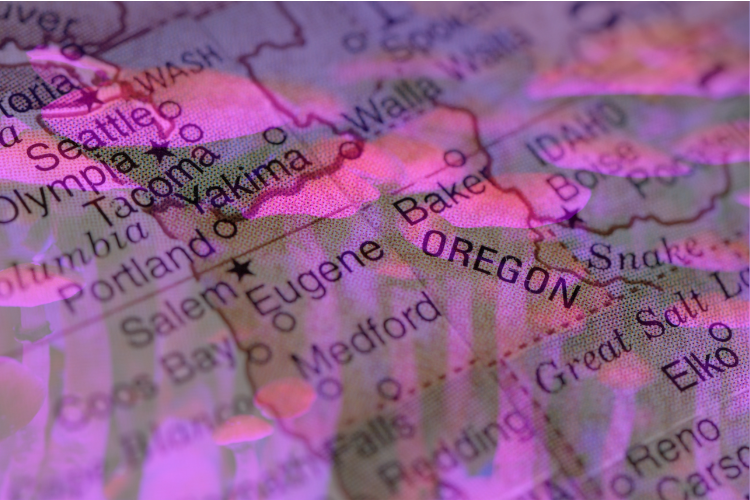
Psilocybin Retreat Center Guide: The Netherlands
The Netherlands, especially Amsterdam, has a long, storied history in regard to psilocybin. Much of it has been sensationalized, if not demonized. The Netherlands is famous for its liberal drug culture and policies, which paved the way for establishing numerous plant medicine retreat centers. In particular, psilocybin retreats in the Netherlands are exploding in popularity.
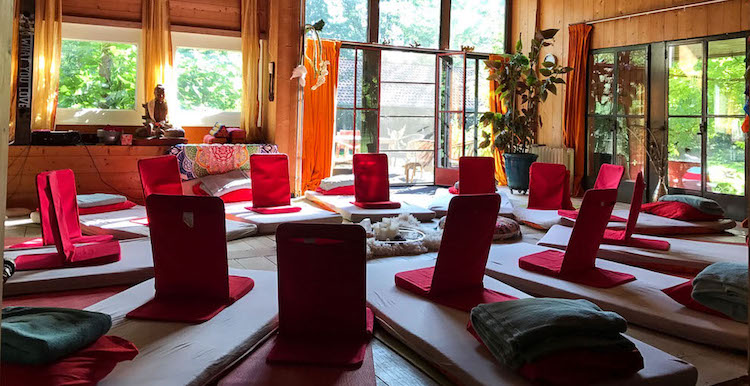
In fact, psilocybin is so popular in the Netherlands that even if you have no time to travel outside of Amsterdam, we think it’s imperative that you don’t miss the best psilocybin retreats in Amsterdam.
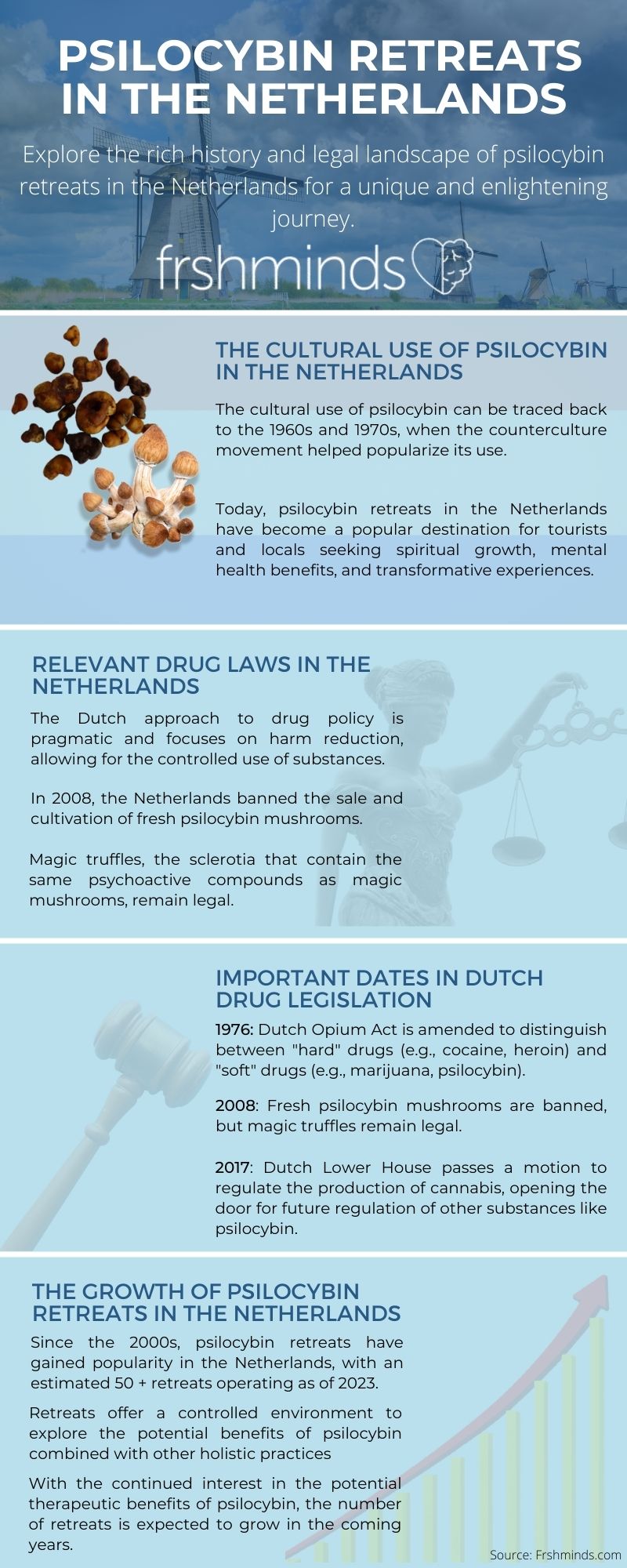
Although it’s not currently legal in the Netherlands to possess the actual fruiting bodies of magic mushrooms, it is legal to possess and consume the less strong but still psychoactive ‘magic truffles‘, the part of the mushroom that grows underground.
Psilocybin Retreat Center Guide: Mexico
How can you and your life change after doing a psilocybin retreat on a tropical beach? Find out by going to a retreat in Mexico!
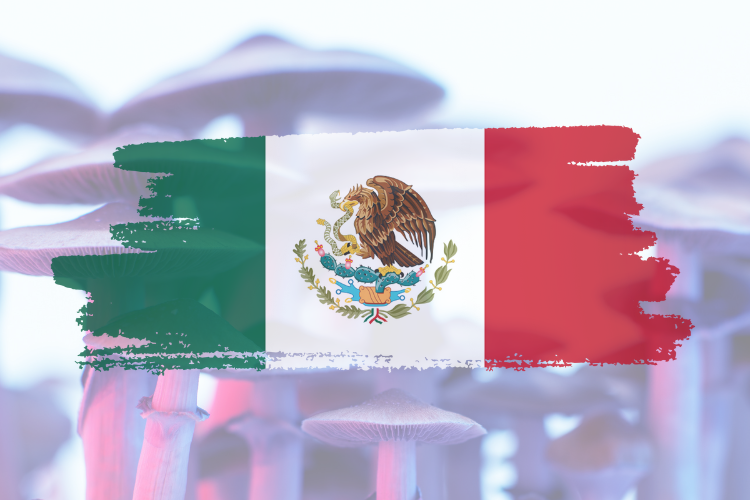
If you know the history of psilocybin, you’ll understand why there are psilocybin retreats In Mexico, as it is rich in psychedelic culture, thanks to its indigenous roots. The depth and breadth of centers, retreats and programs in Mexico can be daunting.
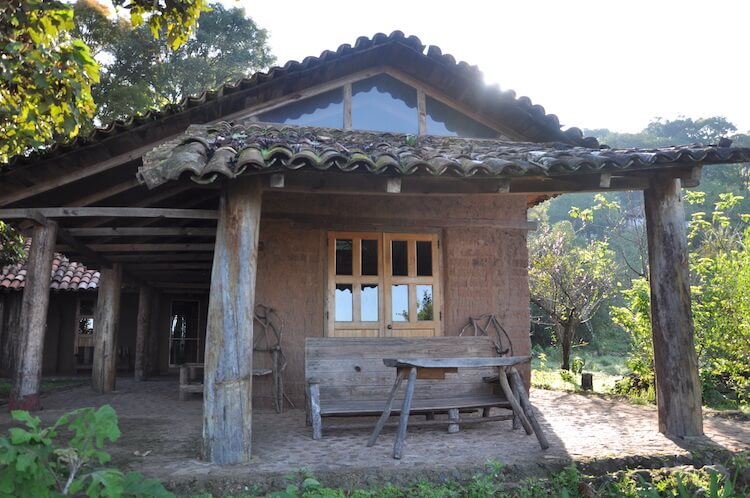
Psilocybin Retreat Center Guide: Jamaica
The obvious response to the question “Do you want to go to a magic mushroom retreat in Jamaica?” is “Which day are we leaving?” Jokes aside, psilocybin is 100% legal in Jamaica, and the Minister of Agriculture of Jamaica said that the government put interim protocols in place to facilitate the cultivation and processing of magic mushrooms. The reality is that the country never promulgated any laws to make psilocybin illegal.
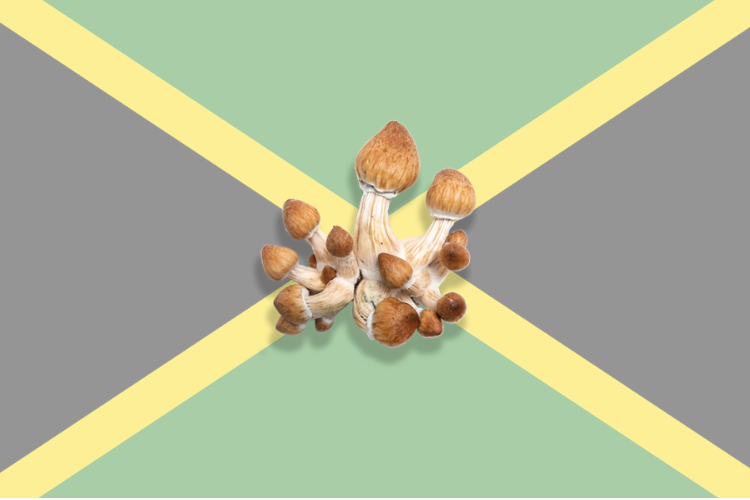
The government aims to market Jamaica as a magic mushroom haven for retreat-goers, and the country is home to a number of retreats, including the high-end resort, MycoMeditations, and long-standing, Kingston-based Sophrodelic.
Psilocybin Retreat Center Guide: Costa Rica
Costa Rica is home to a number of psilocybin retreat centers that share one common denominator, a beautiful setting.
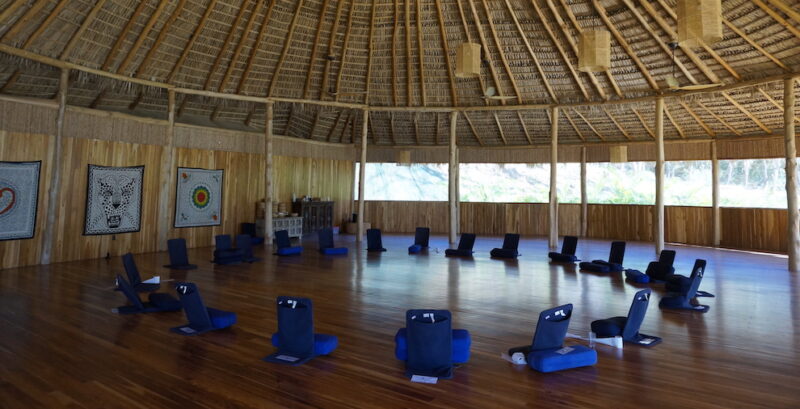
Whether you are looking for a hilltop location or a beachfront property in a tropical location, Frshminds wrote about a number of top-rated psilocybin retreats in Costa Rica worth considering. Find out for yourself the amazing biodiversity that Costa Rica offers and discover what pura vida is all about.
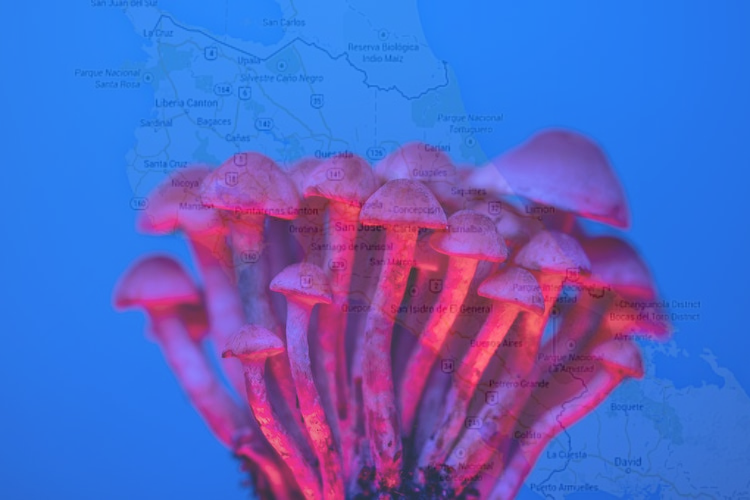
Psilocybin Retreat Center Guide: Conclusion
As we said at the outset, making an educated retreat decision involves knowing the right questions to ask and what to look for. We hope that as you have reached the end of the Psilocybin Retreat Center Guide, you have a better idea of the following:
- The benefits of a psilocybin retreat.
- Why psilocybin may be right for you.
- Psilocybin mushrooms potency and consumption methods.
- What is reasonable to expect when you attend a psilocybin retreat?
Now it’s time to put your knowledge to work and use Frshminds’ psilocybin retreat directory.
More Frshminds Psychedelic Guides
Be sure to check out all of our guides
- The Ultimate Psilocybin Retreat Center Guide
- The Ultimate Ayahuasca Retreat Guide
- Frshminds’ Guide To Ketamine Clinics

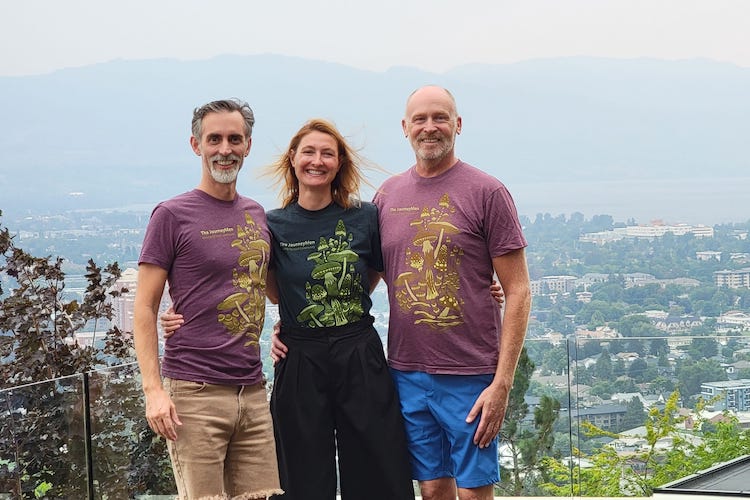

Comments
I thoroughly enjoyed reading your comprehensive guide on psilocybin retreat centers. Your article provides valuable insights into the growing interest in psychedelic experiences and the importance of choosing the right retreat center. Your explanations about the benefits, safety measures, and considerations when selecting a center were particularly helpful.